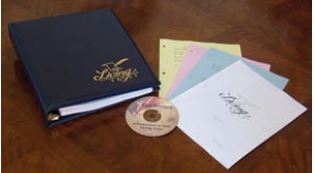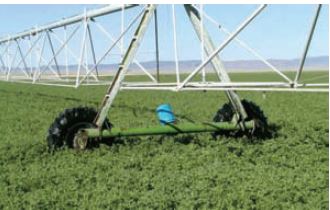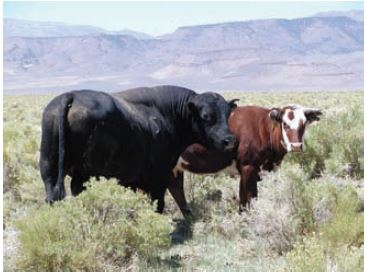Discussing the allocation of your family's farm/ranch assets in the event of death or retirement can be uncomfortable for both the older and younger generations. However, planning for these events in advance may reduce estate tax liability and help to ensure that all parties are satisfied with the plan. Basic elements of estate planning include completing a will and keeping it updated, creating a living will and power of attorney, and setting up both a management and transfer plan for land and other operating assets. The information presented in this fact sheet should not be substituted for professional advice, but can be used as a guide when planning for the future of your farm/ranch.
Estate Taxes
Every estate with a value of $1,000,000 (2006) or more must file an estate tax return. This taxable amount is reduced by deductions for funeral expenses, debts, charitable contributions, and asset transfers to the decedent's spouse. The deductible amount for 2006 is $2 million, but this figure will increase again in 2009. The maximum estate tax rate for 2006 is 46%, which will decrease in 2007. The values are all set forth in the Economic Growth and Tax Relief Reconciliation Act of 2001.
As farmers and ranchers (as well as other small business owners) hold significant amounts of wealth in the form of business assets, they are more likely to owe estate taxes. Combined with such factors as the appreciation of land values, the increase in average farm/ranch size, and increased investment in farm machinery and equipment, farm/ranch estate values have increased. Subsequently, estate taxes due from farmers/ranchers have increased as well.
The creation of the special farm/ranch provisions Federal estate and gift tax policy will increase the deductible amount and decrease the maximum rate in the coming years. These changes have greatly reduced the liquidity issues facing farm/ranch beneficiaries.
Both estate and gift taxes must be paid within nine months of passing or receipt of gift. If at least 35% of the estate's value is a farm or ranch, estate taxes may be paid over a 14-year period in installments. Keep in mind that tax laws change constantly.
Asset Transfer Mechanisms
The following sections outline techniques that may help you plan the future of your farm or ranch. As you read through this information, keep in mind that methods of transfer will greatly affect tax liability on the part of both the older and younger generations.
Trusts
Trusts are temporary legal arrangements that separate the ownership and benefits of an asset. They can be used as both an asset and as a source of income, and are categorized according to when they take effect and whether or not they can be changed. Although almost any type of asset, such as stocks and bonds, can be placed in trust, property is often placed in trust as a tool to transfer and manage the property. Farm/ranch families may consider placing farmland in trust, but should be aware that the trust document should specify how the farm is to be managed.
To set up a trust, a trust document is created outlining the assets to be maintained in the trust. Additionally, the beneficiaries of the trust are designated, and the trustee(s) are appointed. Trustees are required by law to wisely and prudently manage the trust assets. Who should be a trustee? Banks and other financial institutions usually have trust administration departments, or family members or friends may be assigned as trustee(s). Both professional and individual trustee fees are usually set by state law, based on a percentage of the value of assets in the trust. This percentage generally decreases as the value of the assets increase.
Living trust
A living trust is created to permit the separation of management and benefits of trust assets during the grantor's lifetime (hence the name "living trust"). Living trusts are useful in managing assets, or avoiding probate in particularly sensitive or complicated situations.
In most farm family businesses, living trusts may be cumbersome as title to the grantor's assets, including all farm assets, must be transferred into the trust (ex. title to any bank accounts, stock certificates, real estate). The grantor must make this transfer, which is called "funding" the trust. Executing the living trust itself will not cause the trust to be funded.
When a living trust is created, a pour-over will should also be drawn to address the allocation of any assets the grantor purchases or inherits after the living trust was created. Assets obtained after the creation of the trust will be “poured over” into the trust, avoiding probate.
Terminology
Settler/Grantor: Individual who creates a trust.
Beneficiary: Anyone who benefits from the trust or receives income generated by the trust.
Trustee(s): Individual(s) responsible for managing the trust, such as the bank, family member or grantor (in the case of an inter-vivos trust).
Revocable trust: A trust the grantor may choose to end or “revoke” at any time.
Irrevocable trust: A trust that ends only upon an event such as the death of the beneficiary.
Inter-vivos trust: A trust set up during the grantor’s life, often called a “living trust.”
Testamentary trust: A trust set up to take effect after the grantor’s death.
Credit Shelter Trust
A credit shelter trust is specifically created under a will to take advantage of the federal estate tax exemption. Assets equal to the current federal exemption amount are used to fund a trust that typically will pay income to a spouse and distribute the principal to children at the spouse's death. As exemption amounts are slated to rise dramatically over the next several years, this type of trust should be considered very carefully and revisited regularly.
Enterprise Operating Agreement
An enterprise operating agreement can be used as the initial agreement for a two-generation arrangement. The younger party invests capital in the personal property, operating capital, or livestock of one specific enterprise of the family farm/ranch. In exchange for this investment, the younger party receives a portion of the income from the enterprise in the same ratio as his/her contribution of capital, labor, and management. The younger party has no management responsibility and receives a wage for labor performed for enterprises he/she is not invested in.

Buy/Sell Agreements
A buy/sell agreement allows you and your family to prepare for such events as death, divorce, bankruptcy, or retirement that may affect the ownership and operation of your farm/ranch. A buy/sell agreement is a legal document that outlines who can purchase the shares of a departing partner of the business, exactly what events will trigger such a buyout, and the price of the departing member's shares. While a buy/sell agreement can be an excellent way to transfer the ownership of your farm/ranch to the next generation, it is important to keep in mind that a buy/sell agreement will not work if the buyers cannot come up with the money to exercise their right to buy the farm/ranch business.
Gifts
Each individual is allowed to transfer up to $12,000 (2006) annually to an unlimited number of individuals in the form of a gift. Gifts under the allowable amount are not subject to tax, do not count against the amount exempted from the unified tax credit, and can be in the form of either cash or assets. For example, a husband and wife can each give $12,000 to each individual for a total of $24,000. However, gifts in excess of $12,000 per person are subject to estate taxes.
Life Estate
A life estate allows you to donate your farm or home to a charity or nonprofit organization while retaining lifetime use of it for yourself and your spouse, without having it included in your estate. A life estate accomplishes several objectives: it allows you to support your favorite charity or nonprofit organization; you can use an income tax deduction for the present value of your remainder interest in your home or farm; your farm or residence may not be taxed as a part of your estate; and you and your spouse can enjoy your home or farm for the rest of your lives, knowing that it will support a worthy cause in the future.
On the downside, putting your home and/or land into a life estate may make it more difficult to operate your farm, because the future owner may want to have a say in how the property is managed. However, a life estate can be a safe way to keep your farm/ranch property in agriculture after you pass on. This may be of particular importance to families without children, or whose children do not wish to continue working the land.
Machinery Transfer
When passing ownership of farm/ranch machinery and equipment, you must consider the cash flow needs of the buyer as well as the tax consequences to the seller. For example, with an outright sale, taxes from depreciation recapture and capital gains are due in the year of sale. With an installment sale, depreciation recapture and capital gains taxes are still due in the year of sale, but the cash payments are spread out over a number of years. An installment sale may help relieve some of the cash flow issues for the younger generation.
Another option is to sell machinery/equipment to the younger generation one piece at a time so the taxes to both parties are spread out over a number of years. There is also the option of joint ownership, meaning each party retains half-ownership of each piece of equipment, or that each party owns specific items, but continues to use all items. As with all other assets, gifting machinery/equipment may have gift tax implications depending on the value of the item. If you are considering passing machinery/equipment to the next generation in the form of a gift, consult your attorney to be sure it is the best choice for all parties.
If gifting seems like the best choice because the younger party has limited capital, leasing machinery/equipment can be considered. When leasing machinery/equipment, the size of the lease payment may be based on the cost of owning the machine and the amount of time the two parties would like to allow to complete payment. Before entering into a lease agreement, both parties should come to a decision on which party will pay for any repairs during the term of the agreement.
Another option for the case of limited capital is a labor/machinery sharing agreements. Sharing agreements can be used when the younger party "spins off," establishing his/her own separate farming operation. The younger party contributes labor to the older party in exchange for use of machinery, which should be an even exchange. The younger party should be given a wage for labor in excess of machinery contribution.

Land Transfer
An outright cash sale of the farm/ranch and/or farmland/ranchland is not always the best choice for transfer between generations. It is often assumed that selling the property and land to the younger generation rather than bequeathing it will reduce estate and inheritance tax liability. This is not always the case, and is something that should be considered with your tax professional.
If cash flow is an issue for either party, an installment sale may be used. Installment sales of property and land can be spread out over several years, which can help reduce cash flow issues for the younger generation while the older generation uses the payments to cover living and retirement expenses. There are two considerations in an installment sale. First, inflation will reduce the purchasing power of installment payments, especially if payment is spread out over many years. Both parties should plan for this in advance. Second, there is the possibility that the older generation will outlive the payment stream, which is especially important if the older generation has no other source of retirement income. Again, both parties should plan for this situation in advance of the sale.
An option that takes cash flow into account is gifting the land. The gift of land can be included in the gift tax-exempt $12,000 each donor can gift per year (2006). However, a gift is a transfer of property and will not generate income for the older party. If income from the sale of the property is needed to sustain the older party's retirement and/or living expenses, then a gift may not be the best choice.
A final land-transfer option is to simply leave the property to the next generation through a will. This method allows the older party to continue using the property and/or to continue receiving income from the property through their retirement. However, with a will, all taxes will be assessed on the property at the time of passing and may total a significant percentage of the value of the property.
Livestock Transfer
There are several common practices used to pass ownership of livestock from one generation to the next. For breeding livestock, the older party may choose to sell a portion of the herd at a time, while retaining ownership of some of the stock. There is also the roll-over approach, where the older generation retains ownership of the breeding herd, but the offspring of the breeding herd is owned jointly with the younger generation. Over time, all ownership has been "rolled-over" to the younger generation.
Feed and market livestock may be transferred in a slightly different manner. One common method is for the older generation to transfer ownership of the herd to the younger generation at the low point of the feed inventory. Ownership can also be transferred between the sale and replacement of livestock.

Life Insurance
Term and whole life insurance can be valuable elements of your estate plan. Term life insurance pays benefits if the insured party passes on during the term of the contract, while whole life insurance pays benefits and also accumulates a savings account within the policy. Whole life insurance is generally more expensive than term life insurance.
Regardless of the type of life insurance, the proceeds are often income tax-free, and can be used to:
- Generate a tax-free inheritance for your heirs.
- Create a more equitable estate in the case of farm and off-farm heirs: you can transfer the farm to farm children and give the insurance proceeds to off-farm children.
- Pay estate taxes: life insurance can serve as a cost-effective way to make sure that your heirs have cash on hand to pay estate taxes.
- Fund a buy/sell agreement for your heirs. A life insurance policy can also be owned by the business entity and can be used to buy out the deceased person's share of the business.
If used correctly, life insurance may be used to lessen the financial impact of a loss to the farm business.
Summary
Choose the farm transfer and estate planning methods that feel most comfortable for you and your family. As the owner/operator of your business, you are in the best position to decide what's best for you, your family, and your farm/ranch.
For tax purposes, it may make sense for your family to start transferring assets from one generation to the next sooner rather than later. The more time that is allowed for transfer, the more options all parties have to minimize estate, gift, and inheritance taxes. However, it may be wise to delay asset transfers until both generations are comfortable with the commitment. As the owner of your farm/ranch, you are in the best position to evaluate the options and determine what will work best for you, with the guidance of a trained professional.
Locating an Estate Tax Professional
It is essential that you discuss your estate planning and asset transfer plans with an attorney or other tax professional before making any formal decisions. To locate a professional near you, look under "accountants" and/or "attorneys" in your local phone book. Additionally, the State Bar of Nevada runs a free, non-profit Lawyer Referral & Information Service (LRIS). LRIS will help you find an experienced professional based on your needs and location at no cost. For more information, call LRIS at (800) 789-5747.
References
American Farmland Trust. “Farm Transfer and Estate Planning.” Farmland Information Center Fact Sheet and Technical Memo, 2004. Online.
Durst, R., J. Monke, and D. Maxwell. “How Will the Phaseout of Federal Estate Taxes Affect Farmers?” USDA Agriculture Information Bulletin No. 751-02. Online.
Tauer, L.W., and D.A. Grossman. “Estate and Succession Planning for Small Business Owners.” Cornell University Extension Bulletin 98-04. Online.
Cowee, M. and Curtis, K.
2006,
Estate Taxes & Asset Transfer Mechanisms in Agriculture,
University of Nevada Cooperative Extension


